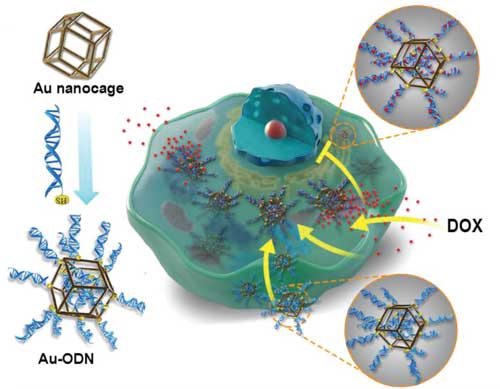| Apr 29, 2019 | |
Nanomaterial-based artificial organelles protect normal cells against chemotherapy side effects(Nanowerk News) A novel strategy for capturing chemotherapeutics in normal cells rather than further optimizing tumor targeting, may reduce the cytotoxicity for normal cell and improve pharmacotherapy. |
|
| Presenting their concept-of-proof study in Advanced Materials ("Nanomaterial-Based Organelles Protect Normal Cells against Chemotherapy-Induced Cytotoxicity"), researchers in China designed nanomaterials to be used as artificial organelles to remove unexpected cytotoxicity in normal cells. | |
| Organelles are specialized structures within cells that carrying out specific tasks. The team synthesized nanocomposites of gold-oligonucleotides (Au-ODN) that can capture intracytoplasmic doxorubicin (DOX) – a standard chemotherapy drug – blocking the drug's access into the cell nucleus. | |
 |
|
| Schematic of the construction of gold-oligonucleotides cnanocomposite and its working principle as a nanomaterials-based organelle within the cell. (Reprinted with permission by Wiley-VCH Verlag) (click on image to enlarge) | |
| The therapeutic agents used in chemotherapy always cause serious negative effects. Since chemical drugs can not distinguish between normal and diseased cells, many of these side effects can be traced to drug-induced damage in normal cells. | |
| In cancer therapy, some drugs such as doxorubicin or cisplatin, bind to double-stranded DNA to inhibit DNA replication in the cell nucleus, inducing apoptosis. However, these anticancer drugs can always induce serious liver damage. | |
| In vivo experiments confirmed that cells with implanted Au-ODN are more robust since their viability is maintained during DOX treatment. The intracellular implantation of the Au-ODN was achieved by incubating these nanomaterials with human normal cells for several hours. | |
| The degree of protection was dependent on the Au-ODN nanomaterials concentration within the cells. The team achieved cell viability of 85% with 27.5 × 10-9 Μ Au-ODN. | |
| "Analogous to cellular organelles, the Au-ODN are responsive to molecular cues and biocompatible in a molecularly crowded cytoplasm, suggesting a novel and promising tactic for constructing artificial organelles via nanomaterials," the authors conclude their report. "More generally, this intracellular implantation of functional nanomaterials into cells provides a proof-of-concept for the construction of super cells with enhanced stress resistance and new functions via nanomaterials." |
 By
Michael
Berger
– Michael is author of three books by the Royal Society of Chemistry:
Nano-Society: Pushing the Boundaries of Technology,
Nanotechnology: The Future is Tiny, and
Nanoengineering: The Skills and Tools Making Technology Invisible
Copyright ©
Nanowerk LLC
By
Michael
Berger
– Michael is author of three books by the Royal Society of Chemistry:
Nano-Society: Pushing the Boundaries of Technology,
Nanotechnology: The Future is Tiny, and
Nanoengineering: The Skills and Tools Making Technology Invisible
Copyright ©
Nanowerk LLC
|
|
|
Subscribe to a free copy of one of our daily Nanowerk Newsletter Email Digests with a compilation of all of the day's news. |
